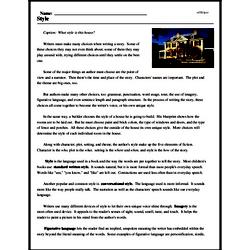Style
Caption: What style is this house?
Writers must make many choices when writing a story. Some of these choices they may not even think about; some of them they may play around with, trying different choices until they settle on the best one.
Some of the major things an author must choose are the point of view and a narrator. Then there's the time and place of the story. Characters' names are important. The plot and the theme are big ones, too.
But authors make many other choices, too: grammar, punctuation, word usage, tone, the use of imagery, figurative language, and even sentence length and paragraph structure. In the process of writing the story, these choices all come together to become the writer's voice, or his own unique style.
In the same way, a builder chooses the style of a house he is going to build. His blueprint shows how the rooms are to be laid out. But he must choose paint and brick colors, the type of windows and doors, and the type of fence and porches. All these choices give the outside of the house its own unique style. More choices will determine the style of each individual room in the house.
Along with character, plot, setting, and theme, the author's style make up the five elements of fiction. Character is the who, plot is the what, setting is the where and when, and style is the how of the story.
Style is the language used in a book and the way the words are put together to tell the story. Most children's books use standard written style. It sounds natural, but it is more formal than most people's everyday speech. Words like "um," "you know," and "like" are left out. Contractions are used less often than in everyday speech.
Another popular and common style is conversational style. The language used is more informal. It sounds more like the way people really talk. The narration as well as the characters' speech sounds like our everyday language.
Writers use many different devices of style to let their own unique voice shine through. Imagery is the most-often used device. It appeals to the reader's senses of sight, sound, smell, taste, and touch. It helps the reader to paint a picture in his mind from the author's words.




